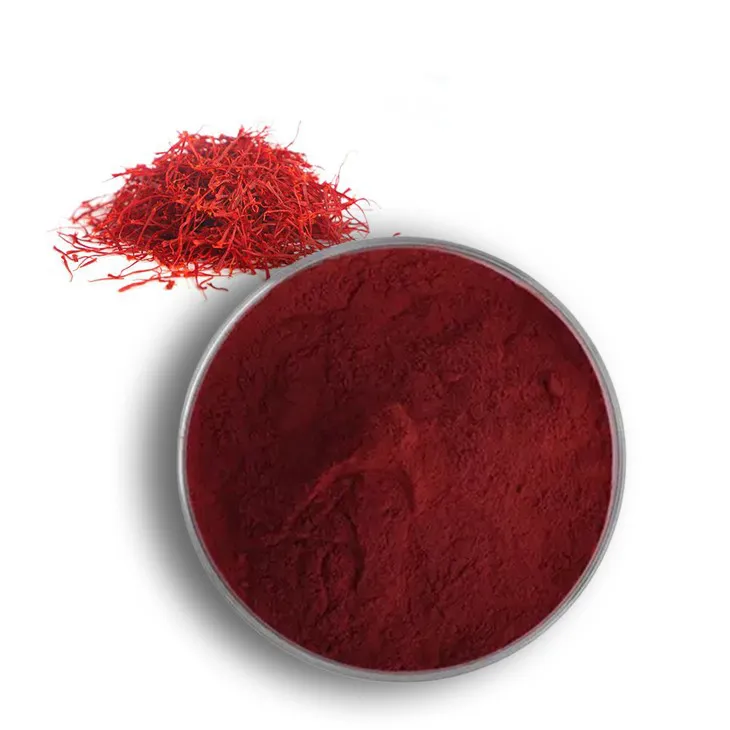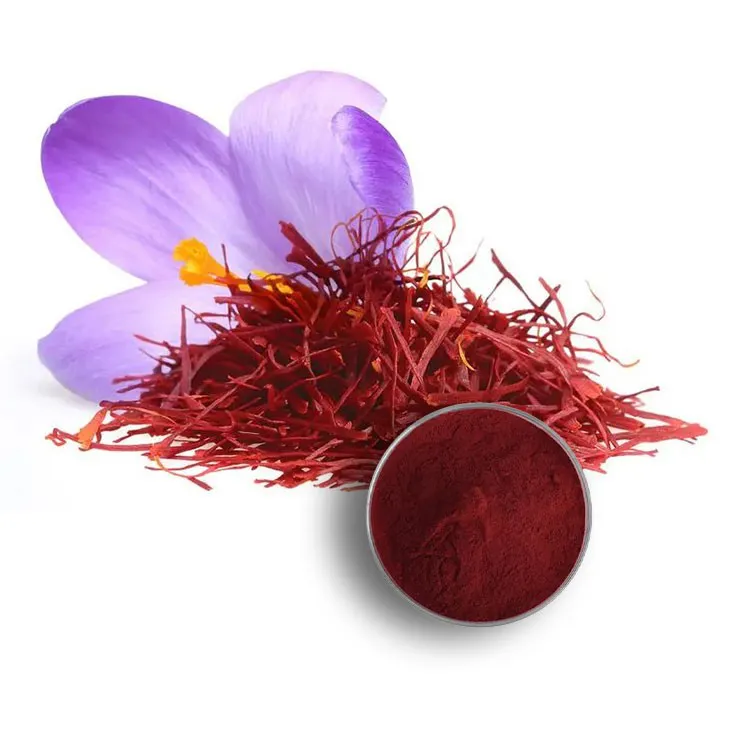- 0086-571-85302990
- sales@greenskybio.com
The process of extracting safranal from saffron extract powder.
2024-11-26

1. Introduction to Saffron and Safranal
Saffron, a precious spice, is derived from the dried stigmas of the Crocus sativus flower. It has been used for centuries in cooking, traditional medicine, and as a dye. Saffron is known for its distinct flavor, color, and aroma, which are attributed to its complex chemical composition.
Safranal is one of the most important components in saffron. It is responsible for the characteristic aroma of saffron. Chemically, safranal is a monoterpene aldehyde. Its presence not only gives saffron its unique smell but also contributes to its potential health benefits and various applications in different industries.

2. Collection and Storage of Saffron for High - Quality Extract Powder
2.1 Collection
The collection of saffron is a meticulous process. Saffron stigmas are hand - picked at the right time to ensure optimal quality. The flowers are usually harvested in the early morning when the stigmas are most receptive. This careful harvesting is crucial as any damage or improper timing can affect the chemical composition of the saffron and, subsequently, the quality of the extract powder.
2.2 Storage
Proper storage of saffron is essential to maintain its quality. Saffron should be stored in a cool, dry place, away from sunlight and moisture. It is often stored in airtight containers to prevent oxidation and degradation of its components. Good storage conditions help preserve the safranal content and other valuable compounds in saffron, which is vital for the production of high - quality extract powder.

3. Extraction Methods
3.1 Traditional Chemical Extraction Methods
Traditional chemical extraction methods have been used for a long time to extract safranal from saffron. One common method is solvent extraction.
- Solvent selection: Different solvents can be used, such as ethanol, methanol, or hexane. Ethanol is often preferred due to its relatively low toxicity and ability to dissolve a wide range of saffron compounds. The choice of solvent depends on factors such as the solubility of safranal and other components, as well as the desired purity of the extract.
- Extraction process: The Saffron Extract Powder is mixed with the solvent in a suitable ratio. This mixture is then stirred or shaken for a specific period, usually several hours to ensure sufficient extraction. After that, the mixture is filtered to separate the solvent - containing safranal from the solid residue.
However, traditional chemical extraction methods may have some drawbacks. For example, they may require large amounts of solvents, which can be costly and may pose environmental concerns. Also, the extraction efficiency may not be as high as desired in some cases.
3.2 Enzymatic Extraction Methods
Enzymatic extraction is a relatively newer approach for extracting safranal from saffron.
- Enzyme type: Different enzymes can be used, such as cellulases and pectinases. Cellulases can break down the cell wall components of saffron, facilitating the release of safranal. Pectinases, on the other hand, can hydrolyze pectin, which is also present in saffron, and improve the extraction efficiency.
- Reaction time: The reaction time is an important parameter in enzymatic extraction. It typically ranges from a few hours to a day, depending on the enzyme concentration, temperature, and other factors. Optimal reaction time needs to be determined experimentally to ensure maximum safranal extraction.
- Advantages: Enzymatic extraction has several advantages over traditional methods. It can be more environmentally friendly as it may require less solvent. It also has the potential to be more specific in extracting safranal, resulting in a higher - quality extract with fewer impurities.

4. Separation of Safranal from the Extract Mixture
4.1 Centrifugation
Centrifugation is a commonly used method for separating safranal from the extract mixture. The principle behind centrifugation is to use centrifugal force to separate substances based on their density differences.
- Process: The extract mixture is placed in a centrifuge tube and spun at a high speed. The heavier components, such as cell debris and some impurities, will sediment at the bottom of the tube, while the supernatant, which contains safranal and other soluble components, can be collected for further processing.
- Optimization: The speed and time of centrifugation need to be optimized. Higher speeds may lead to better separation, but excessive speed may also cause damage to the safranal or other valuable components. Similarly, the centrifugation time should be adjusted according to the nature of the extract mixture to ensure complete separation.
4.2 Filtration
Filtration is another important separation method.
- Types of filters: There are different types of filters that can be used, such as paper filters, membrane filters, and sintered filters. Paper filters are simple and cost - effective but may not be suitable for very fine separation. Membrane filters, on the other hand, can provide a higher level of filtration precision, depending on their pore size.
- Filtration process: The extract mixture is passed through the filter. The solid particles are retained on the filter, while the filtrate, which contains safranal, passes through. Filtration can be carried out under normal pressure or with the aid of a vacuum to speed up the process.
5. Quality Control Aspects
5.1 Determination of Safranal Purity
Determining the purity of safranal is crucial for ensuring the quality of the extract. One common method is chromatography.
- Gas chromatography (GC): GC is widely used for analyzing safranal. It can separate the different components in the extract based on their volatility. By comparing the peak area of safranal with that of other components, the purity of safranal can be determined. Calibration standards are used to ensure accurate quantification.
- High - performance liquid chromatography (HPLC): HPLC can also be used, especially for samples where safranal may not be easily volatilized. It provides a more detailed analysis of the components in the extract, allowing for a more precise determination of safranal purity.
5.2 Determination of Safranal Concentration
Knowing the concentration of safranal is important for various applications. Spectrophotometric methods can be used to measure the concentration.
- UV - Vis spectrophotometry: Safranal has characteristic absorption wavelengths in the UV - Vis region. By measuring the absorbance of a sample at these wavelengths and using Beer - Lambert's law, the concentration of safranal can be calculated. However, this method may be affected by the presence of other components in the extract that also absorb at similar wavelengths, so proper sample preparation and calibration are necessary.
6. Conclusion
6.1 Potential of Safranal in Different Industries
Safranal has great potential in various industries. In the food industry, it can be used as a natural flavoring agent, adding the unique saffron aroma to products. In the perfume industry, its pleasant smell can be incorporated into fragrances. In the pharmaceutical and nutraceutical industries, safranal may have antioxidant, anti - inflammatory, and other potential health - promoting properties, which make it a valuable ingredient in dietary supplements and drugs.
6.2 Contribution of an Improved Extraction Process
An improved extraction process for safranal from Saffron Extract Powder can significantly contribute to its wider utilization. By optimizing the collection, storage, extraction, and separation steps, as well as ensuring strict quality control, more high - quality safranal can be obtained. This will not only meet the increasing demand for safranal in different industries but also promote the sustainable development of saffron - related products.
FAQ:
What is the significance of safranal in saffron?
Safranal is one of the important chemical components in saffron. It contributes to the characteristic flavor and aroma of saffron, and also has certain biological activities. It is widely used in the fields of food, perfume and medicine.
How to ensure the high - quality collection and storage of saffron for extract powder?
For high - quality collection, saffron should be harvested at the appropriate time. The stigmas should be carefully picked to avoid damage. In terms of storage, it should be stored in a cool, dry and dark place, preferably in an air - tight container to prevent moisture absorption and oxidation, which can help to maintain the quality of saffron for making high - quality extract powder.
What are the main differences between enzymatic extraction and traditional chemical extraction methods of safranal?
Enzymatic extraction uses enzymes to break down cell walls and release safranal, which is generally more specific and may cause less damage to other components. It often requires specific enzyme types and reaction time optimization. Traditional chemical extraction may use solvents such as ethanol or methanol. It may be more effective in some cases but may also introduce more impurities. The choice between them depends on various factors such as the required purity, cost and scale of production.
How does centrifugation help in the separation of safranal from the extract mixture?
Centrifugation works by applying a centrifugal force to the extract mixture. Due to the difference in density between safranal and other components in the mixture, safranal can be separated. The heavier particles or components will be sedimented at the bottom, while safranal, which may have a different density, can be separated in the supernatant or at a different layer depending on its properties.
Why is quality control important after safranal extraction?
Quality control after extraction is crucial because it ensures the purity and concentration of safranal meet the required standards. If the purity is not high enough, it may affect its performance in various applications such as in food flavoring or in medicinal products. The accurate determination of concentration is also necessary for proper dosage in different industries.
Related literature
- The Chemistry and Bioactivity of Saffron"
- "Advances in Saffron Extraction and Analysis"
- "Safranal: Properties, Extraction and Applications"
- ▶ Hesperidin
- ▶ Citrus Bioflavonoids
- ▶ Plant Extract
- ▶ lycopene
- ▶ Diosmin
- ▶ Grape seed extract
- ▶ Sea buckthorn Juice Powder
- ▶ Fruit Juice Powder
- ▶ Hops Extract
- ▶ Artichoke Extract
- ▶ Mushroom extract
- ▶ Astaxanthin
- ▶ Green Tea Extract
- ▶ Curcumin
- ▶ Horse Chestnut Extract
- ▶ Other Product
- ▶ Boswellia Serrata Extract
- ▶ Resveratrol
- ▶ Marigold Extract
- ▶ Grape Leaf Extract
- ▶ New Product
- ▶ Aminolevulinic acid
- ▶ Cranberry Extract
- ▶ Red Yeast Rice
- ▶ Red Wine Extract
-
Red Vine Extract
2024-11-26
-
Senna Leaf Extract
2024-11-26
-
Hawthorn powder
2024-11-26
-
Curcumin Extract
2024-11-26
-
Kidney Bean Extract
2024-11-26
-
Scutellaria Extract
2024-11-26
-
Kupilu Extract
2024-11-26
-
Citrus bioflavonoids
2024-11-26
-
Longan Extract
2024-11-26
-
Green coffee bean Extract
2024-11-26





















